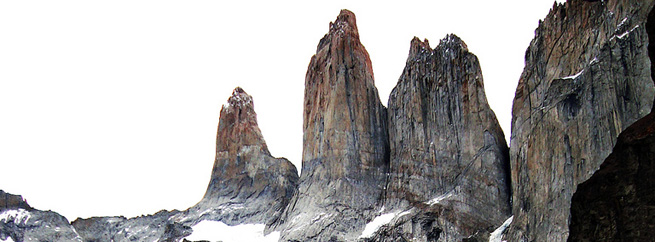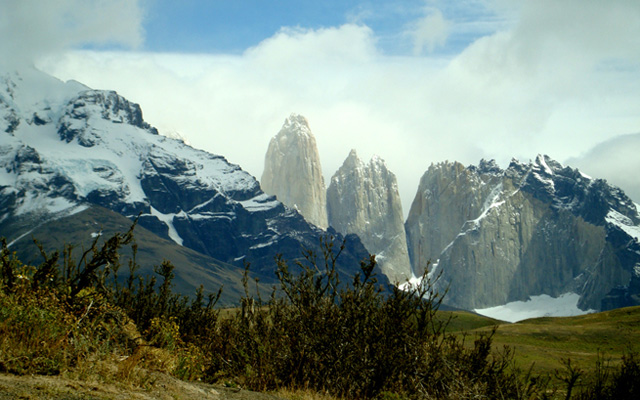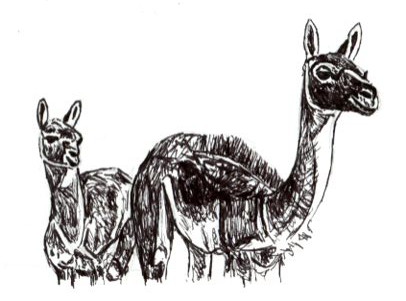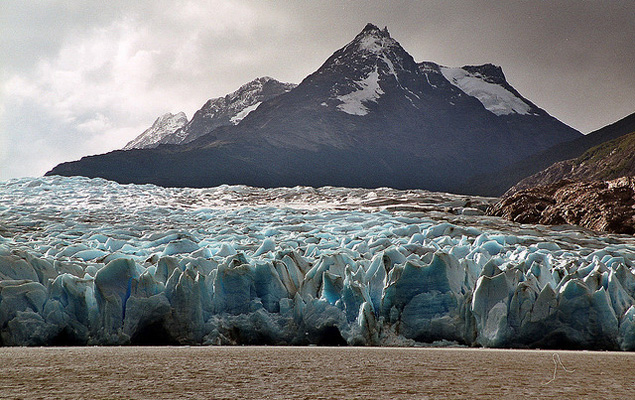
A wild but fragile Chile: Torres del Paine National Park
22 August, 2011Torres del Paine National Park is found in the Última Esperanza province of Southern Chile , approximately 250km north of Punta Arenas. This 242,000 ha area is dissected by a complex physiography characterized by the Southern Patagonian Ice Fields and the Cordillera del Paine – an impressive mountain range that is claimed to rise over 3,000m.
Black, sedimentary rock dominates the mountains, its strata showing complex folds resulting from tectonic deformation during the formation of the Andes. But these dark mountains are also streaked with pale granite, which formed when magma rose from the depths 13 million years ago, becoming trapped and slowly solidifying to form what is known as a laccolith. Resistant enough to withstand the glacial erosion that removed overlying rock, this granite is now left exposed.
Three large granite towers, the Torres del Paine, project into the sky like the armoured back of a spiny dinosaur. Glacial forces have sculpted an incredible landscape, dominated by the Paine massif, whose mountains are separated by small valleys, such as the Valle del Frances. The head of this valley is a cirque, formed by glacial erosion and encased by steep cliffs. Such contrasting relief impacts upon the regions climate, with the mountains creating an abrupt moisture gradient in a west-east direction fluctuating from 1,000 to 3,000 mm in annual precipitation. Described as having a sub polar cold and dry climate, average temperatures range from 4 to 16˚C in summer, while in winter freezing temperatures occur, with an average of 2˚C. Wind gusts often exceed 80 km/h.

A harsh environment it would seem in which to make a living. But Torres del Paine is no bleak wilderness. Yet westerly winds and the storms that accompany them have been important in inducing changes in the vegetation that is found in Torres del Paine. The regions diverse vegetation ranges from arid-steppe communities, composed of grasses and scrub shrubs, to mixed Nothofagus spp., or southern beech, forests in moister areas. On mountain slopes and in valleys pure stand forests dominated by N. pumilio, Lenga beech, can be found. The forest-steppe ecotone is a sensitive vegetation and climate boundary, with precipitation falling over the Cordillera determining the development of forests in the semi-arid eastern lowland areas that are impacted by the mountains rain shadow effect.
Pulses of increased precipitation associated with westerly winds over the last 5,000 years drove shifts in the forest-steppe ecotone, with the establishment and persistence of closed-canopy forests in the years prior to European settlement. Reversals in this trend in intermediate years created dry phases, and the decline in precipitation, combined with previous forest growth, provided an ideal environment for fire. But it was in the years after European settlement that fire activity intensified, with slash and burn practices causing a transition from forests to grasslands, used for livestock and agriculture, and scrub-land communities dominated by N. antarctica, Antarctic beech, and N. pumilio, due to their ability to regenerate following disturbance. Introduction of exotic weeds by European settlers was also a contributing factor to the rapid decline in forest.
But fire has also been a recent threat. On 17 February 2005, a wildfire was ignited at Torres del Paine, when a tourist accidentaly knocked his stove onto ground vegetation. The fire lasted for approximately four weeks, beginning on grassland, but spreading rapidly towards other areas, destroying valuable habitats including steppes, shrublands and forests. In total, 17,000 ha of the park and adjacent private lands were affected by the fire, including approximately 2,000 ha of N. pumilio forests. Regeneration and restoration of forest following fire is made difficult by a number of factors. The collapse in canopy exposes N. pumilio seedlings to incoming radiation and the drying effects of strong winds, which, along with decreased soil organic matter and nitrogen, strongly limits the seedlings survival. Exotic species introduced by Euro-Chilean settlers into areas previously disturbed by fire however, become more abundant in burned areas, further impeding forest regeneration.
In Chile wilderness areas are increasingly subjected to anthropogenic pressure arising from recreation and settlement in surrounding areas. Torres del Paine National Park was designated a World Biosphere Reserve by UNESCO in 1978, making it a protected area. The diversity of the park’s vegetation – consisting not only of steppe, shrubland and forest, but also, beyond the tree line, the Andean Desert – provides habitats for a large number of mammals. Examples include the puma (Felis concolor), the endangered South Andean deer or huemal (Hippocamelus bisculus), the Chilla fox (Pseudalopex griseus), the Culpeo fox (Pseudalopex culpaeus), the hog-nosed skunk (Conepactus humboldtii), the long-tailed pygmy rice rat (Oligoryzomys longicaudatus) and the Near Threatened Geoffroy’s cat (Leopardus geoffroyi). But it is the guanaco (Lama guanicoe) that you may be most likely to spot upon arriving in the park.

A member of the Camelidae family, the guanaco is one of the two wild relatives of the llama and alpaca. Guanacos are listed as threatened throughout most of their range and some populations are classified as regionally endangered. Poaching, disruption of migration routes, habitat loss and fragmentation, and competition with livestock are the guanacos’ primary threats. In Torres del Paine, guanaco populations have benefited from limitations on livestock grazing. However, concern remains over loss of certain habitat. Locally referred to as “vegas”, wetlands are areas rich in plant biodiversity, and as such represent an important resource for animals such as the guanaco. Guanacos exhibit resource defence polygyny, whereby males seek out habitats that are favourable for attracting females. Mating guanacos have been observed disproportionately on vega habitats, perhaps due to the abundance of forage, but the open, flat terrain may also help prevent predation by their stalking predator, the puma.
Road construction and gravel mining in Torres del Paine National Park has eliminated several wetlands, some of which are unusual and are not found outside of South America. Torres del Paine is also home to 105 bird species, at least a third of which depend on wetland habitats for food, nesting habitat and/or water resources. Birds that can be sighted within Torres del Paine include the Chilean flamingo (Phoenicopterus chilensis), Darwin’s rhea (Rhea pennata), Coscoroba swan (Coscoroba coscoroba), Magellanic woodpecker (Campephilus magellanicu) and Black-faced ibis (Theristicus melanopis). The park also contains breeding populations of 15 bird of prey species, including Black-chested buzzard-eagles (Geranoaetus melanoleucus), Chimango caracaras (Milvago chimango), Austral pygmy owls (Glaucidium nanum), and not to forget, the national symbol of Chile – the Andean condor (Vultur gryphus). This bird is considered as near threatened, and although their numbers within the park do not seem to be declining, concern has been raised over changes in roosting behavior in response to humans.
Tourism in Torres del Paine has increased dramatically, rising from less than 4,000 visitors in 1983 to over 60,000 in 2001. During this time, the number of vehicles entering the park increased from less than 1,500 to over 9,000. This increase in vehicle traffic within the park has had other impacts. Engines run on leaded petrol release lead into the environment through exhaust emission. Atmospheric samples collected in Torres del Paine in 1983 showed some of the lowest pollutant loadings recorded on the planet, with only samples from Antarctica having lower concentrations. Lead pollution has also been measured by sampling mosses in the park. Data from 1984 showed that lead concentrations in moss were some of the lowest reported in the scientific literature. However, moss concentrations have since increased, rising from less than 0.3 PPM in 1984 to 2 PPM by 1997. Lead concentrations in moss from the monitoring sites were strongly correlated with tourist usage and vehicle traffic in the park, suggesting that increasing exhaust emission could explain the rise in moss lead contamination.
Some areas of the park are also sensitive to more global threats. The Patagonian Ice Fields are one of the largest non-polar ice bodies in the world, and are particularly sensitive, with short response times to climate change. Torres del Paine was once a very cold place, its climate structure after the Last Glacial Maximum being more akin to that of Antarctica than the Northern hemisphere. Evidence has been found for a short-lived still-stand or re-advance of Patagonian ice culminating at 12-15,000 yr BP, with the glacier extending some 40 km beyond the present ice margin. The timing of the glacier stage coincides with a cooling event recorded in Antarctic ice cores, termed the Antarctic Cold Reversal, suggesting that Patagonian glaciers were out of phase with those in the northern hemisphere, where records indicate atmospheric and oceanic warming.
Approximately 10,000 years ago the ice retreated, and today, glaciers in the southeastern part of the Southern Patagonian Ice Field are shrinking considerably, with a total area loss of 6.2 km2, which represents 8% of the total ice area of 1945. Large glaciers over 10 km long, like those found in Patagonia, cannot be monitored effectively using the traditional stake-method, because of logistic constraints and difficulties in measuring high accumulation and ablation rates. A solution to this problem was sought in 2001, when a laser scanner and a navigation system were attached to a Twin Otter airplane of the Chilean Air Force, and flown 235 km over Glacier Tyndall in Torres del Paine. This confirmed the ice thinning acceleration trend observed in Patagonia during recent years, presumably in response to warmer and drier conditions.

Found almost at the very tip of South America, where the land begins to give way to the Atlantic Ocean, in some respects Torres del Paine could be seen as a fragile place, sensitive to environmental forces, such as the westerly winds that helped shape the park that is found today. Its remote and wild location has no doubt helped it to remain one of the least anthropogenically influenced places in the world. And although the area has seen increasing tourism and development more recently, it still supports some of the most robust wildlife populations, such as those of the guanaco. It is no surprise that the number of visitors has increased so dramatically, given the parks incredible beauty. But much of this beauty stems from the regions unspoiled nature. The vulnerability of the park to accidents as simple as a knock to a camp stove, should not be underestimated. Lessons like these are hopefully ones that will not have to be repeated.
Follow Sounds and Colours: Facebook / Twitter / Instagram / Mixcloud / Soundcloud / Bandcamp
Subscribe to the Sounds and Colours Newsletter for regular updates, news and competitions bringing the best of Latin American culture direct to your Inbox.

